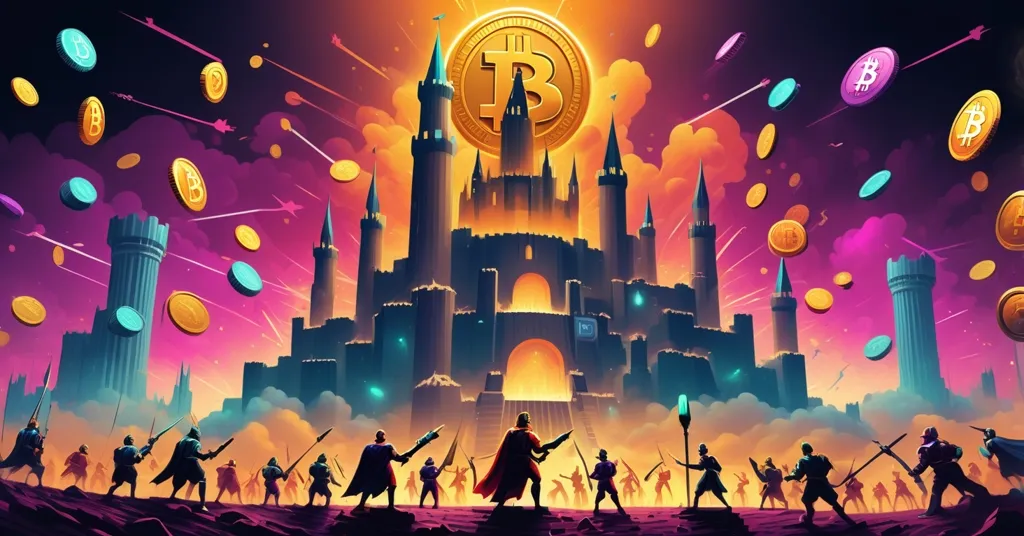XRP, Cardano, Worldcoin Price Predictions: Bullish 2025 Outlook or Risky Hype?

Crypto Price Predictions for XRP, Cardano, and Worldcoin: Bullish Hype or Hard Reality?
Bitcoin’s jaw-dropping climb to an all-time high of $122,838 last month has lit a fire under the cryptocurrency market, pushing the total market cap to $3.9 trillion with a 3% gain in just 24 hours. Amid this frenzy, altcoins like Ripple (XRP), Cardano (ADA), and Worldcoin (WLD) are grabbing headlines with bold price forecasts, while new meme coins and whispers of U.S. regulatory clarity add fuel to the speculative blaze. But let’s not get carried away—wild gains come with wild risks, and we’re here to break it down without the fluff.
- Market Momentum: Bitcoin’s peak and a $3.9 trillion market cap drive altcoin optimism.
- Altcoin Focus: XRP, Cardano, and Worldcoin show technical promise for massive gains by 2025-2026.
- Reality Check: Volatility, privacy scandals, and regulatory uncertainty could derail the hype.
The crypto space is a high-stakes battlefield right now, with Bitcoin leading the charge as the ultimate symbol of decentralization and freedom. As a Bitcoin maximalist, I see it as the unshakeable core of this financial revolution, but altcoins are carving out niches—some useful, others dubious—that Bitcoin doesn’t (and shouldn’t) touch. From XRP’s payment prowess to Worldcoin’s dystopian eyeball scans, there’s plenty to unpack. Add in a Solana-based meme coin with trading gimmicks and the SEC teasing regulatory relief, and you’ve got a market ripe for both innovation and implosion. Let’s dive into the details, dissect the predictions, and separate fact from fantasy with a no-nonsense lens.
Bitcoin: The Anchor of This Bull Run
Before we get to the altcoin circus, let’s ground ourselves with Bitcoin. Hitting $122,838 last month, it’s not just a price milestone—it’s a statement. Despite a 5% pullback since, Bitcoin remains the benchmark for the entire crypto market, dragging altcoins up (or down) with its gravitational pull. Historically, BTC’s surges—like in 2017 or 2021—have fueled altcoin rallies, only to crush them when sentiment flips. With a yearly gain of 103%, it’s outperforming traditional assets, embodying the ethos of decentralization and financial sovereignty that drew many of us to this space in the first place. For deeper insights into how Bitcoin influences other cryptocurrencies, check out this analysis on Bitcoin’s market impact on altcoins in 2025.
But Bitcoin’s volatility is a double-edged sword. That 5% dip from its peak reminds us how quickly gains can evaporate, often taking altcoin dreams with it. As we cheer for XRP or Cardano to moon, remember: Bitcoin’s dominance—both in market cap (over 50% typically) and cultural weight—means its sneezes cause altcoin colds. It’s the gold standard of freedom from fiat tyranny, and while altcoins have their place, they’re often just side bets in Bitcoin’s bigger game.
Ripple (XRP): Payment Powerhouse with a Legal Hangover
Technical Breakout and Bold Targets
Ripple’s XRP has been turning heads, blasting past its 2018 high of $3.40 to peak at $3.65 on July 18. Now trading at $3.08 after a 15.8% correction, it’s still up 4.4% in the last 24 hours and a hefty 34% over the past month. That’s a staggering 494% yearly gain, leaving Bitcoin’s 103% in the dust. XRP is built for speed—think near-instant, dirt-cheap cross-border payments—and it’s won institutional trust, with endorsements from heavyweights like the United Nations for global transaction potential. For a comprehensive look at this cryptocurrency, explore this detailed overview of Ripple XRP. On the charts, things look promising: a Relative Strength Index (RSI) of 54 means it’s not overbought yet (for the uninitiated, RSI is like a speedometer for market momentum, showing if a coin’s overheating or has room to run). Bullish flag patterns—technical setups signaling potential upward breakouts—hint at a push to $4 soon.
Some analysts are even more bullish. Trader @nology3000, using Elliott Wave theory (a method to predict price cycles based on crowd psychology), projects a Wave (3) rally with targets between $6 and $8 after consolidation around $5.50-$6.00. Yashu Gola from FX Empire pegs a nearer-term target of $3.80—a 27% jump—if trading volume confirms a breakout above the current wedge pattern. That’s tantalizing for anyone holding XRP, especially compared to Bitcoin’s slower grind as a store of value. For more on this technical analysis, see this XRP price forecast for 2025.
The Downside Nobody’s Hyping
But don’t start counting your lambos yet. If XRP slips below its 50-day Exponential Moving Average (EMA) at $2.79—a key support level that smooths out price trends over 50 days—it could crater to $2.35-$2.40, wiping out recent gains in a heartbeat. And then there’s the ghost of regulatory past. Ripple’s brutal multi-year battle with the U.S. Securities and Exchange Commission (SEC), though resolved, left scars on its price and reputation. While the legal coast seems clear now, any new whiff of government meddling could send investors running. XRP’s strength in payments is undeniable—Bitcoin can’t match its speed for transactions—but legal and technical risks mean it’s not a slam dunk. For a deeper dive into these challenges, read about XRP’s legal battles and price impact. Tread carefully; this isn’t a risk-free ticket to the moon.
Cardano (ADA): Green Blockchain with Big Ambitions
Sustainability and Smart Contracts
Cardano, often hyped as an “Ethereum killer,” is staking its claim with a focus on sustainability and rigorous research. Its token, ADA, sits at $0.7705, up 6.4% in the last 24 hours and 32% over the past month, with a market cap north of $27.9 billion. Unlike Bitcoin’s energy-hungry Proof-of-Work, Cardano runs on Ouroboros Proof-of-Stake, slashing energy use and appealing to eco-conscious investors. Forecasts are audacious: analysts see ADA climbing to $1.50 by fall and possibly $3.09 by year-end, a potential 300% surge if momentum holds. Curious about community perspectives on these predictions? Check out this Cardano price discussion on Reddit.
Founded by Ethereum co-founder Charles Hoskinson, Cardano’s methodical approach—think peer-reviewed upgrades over reckless launches—sets it apart. It’s a platform for decentralized apps (dApps) and smart contracts, directly challenging Ethereum’s turf but with a greener footprint. Political buzz adds spice: former President Donald Trump name-dropped Cardano, alongside Solana and XRP, as candidates for a potential U.S. crypto reserve portfolio. That’s not policy, but it’s the kind of mainstream nod that can spark institutional buying. Compared to Bitcoin, ADA’s use case isn’t about being digital gold—it’s about powering a decentralized internet.
Challenges in a Crowded Field
Yet, Cardano isn’t without hurdles. Breaking past psychological resistance like the $1 mark will need serious volume, and its dApp ecosystem, while growing, lags behind Ethereum’s sprawling network. Critics point out that Cardano’s slow, deliberate pace—while admirable for stability—can leave it playing catch-up in a fast-moving space. Bitcoin maximalists like myself might argue it’s a distraction from BTC’s core mission of financial sovereignty, though I’ll concede it fills a smart contract niche Bitcoin doesn’t touch. The upside looks strong if Cardano executes, but competition is fierce, and overhyping it as the next big thing ignores the brutal blockchain battleground.
Worldcoin (WLD): Futuristic Vision or Privacy Disaster?
Biometric Ambition and Market Potential
Worldcoin is the oddball of crypto, and that’s putting it mildly. Boasting nearly 15 million users across 160 countries, it’s pushing a global identity and financial network by distributing tokens to people who prove they’re human via biometric iris scans with “Orb” devices. Essentially, you stare into a futuristic eyeball scanner, get verified as unique, and receive WLD tokens as a reward—a sort of universal basic income on the blockchain. Tied loosely to OpenAI’s Sam Altman, WLD faces resistance between $2 and $2.50 but could revisit highs of $4, or even soar to $11.74, if market tailwinds and hype (like OpenAI’s upcoming ChatGPT-5 release) align.
The concept is wild and ambitious, aiming to solve identity fraud in a digital age. But let’s be real: scanning your iris to join a crypto experiment sounds like something out of a sci-fi dystopia. From a market perspective, bullish momentum tied to AI advancements might push WLD higher, especially in a 2025 bull run. Compared to Bitcoin’s pure decentralization, Worldcoin is a far cry, but it’s chasing a niche of digital identity that BTC doesn’t address.
Ethical Quagmire and Red Flags
Here’s where the stench of controversy kicks in. Ethereum’s Vitalik Buterin has ripped into Worldcoin for privacy risks and centralization flaws—concerns echoed across forums like Reddit, where users slam deceptive marketing and fear their biometric data could end up on the black market. For a community-driven take, see this Reddit discussion on Worldcoin privacy issues. Many who scanned their irises report feeling shortchanged, with token rewards not matching the personal data they’ve surrendered. Regulatory heat has shadowed the project since 2022, with bans or scrutiny in multiple regions over data security. If a breach happens, your eyeball data isn’t something you can reset like a password. For another perspective on these concerns, take a look at this Quora thread on Worldcoin’s biometric data collection.
Frankly, Worldcoin’s model feels like a betrayal of crypto’s core ethos of privacy and freedom—principles Bitcoin champions without asking for your literal identity. The bullish case tied to AI hype is flimsy when stacked against ethical landmines. Betting on WLD isn’t just a price gamble; it’s a wager on whether society will stomach this invasive tech. For me, it’s a hard pass until they prove data safety isn’t just a PR line.
Snorter ($SNORT): Meme Coin Gimmick or Genuine Utility?
Now for something lighter—but no less risky. Snorter ($SNORT), a Solana-based meme coin in presale, has raised over $2.8 million at $0.1005 per token. Unlike the endless parade of Dogecoin clones, it’s pitching utility with its virality: trading tools like front-running-resistant swaps, scam detection, and copy trading for a 0.85% fee, rivaling platforms like BonkBot or Maestro. Staking rewards up to 154% APY sweeten the pot for early buyers. Built on Solana’s high-speed, low-cost blockchain, it’s riding the meme coin wave with a dash of practicality.
But let’s cut the crap—meme coins are crypto’s casino, and most end up as digital confetti. Historical flops like countless Shiba Inu knockoffs show that 90% of these projects bleed out within a year, per various market studies. Snorter’s tools are cute, but without a rabid community or real adoption, it’s likely just another pump-and-dump waiting to happen. Bitcoin’s value as sound money laughs at this speculative nonsense, though I’ll admit Solana’s ecosystem lets meme coins test quirky ideas BTC wouldn’t host. If you’re throwing cash at Snorter, treat it like a lottery ticket—don’t whine when it’s a bust.
Regulatory Horizon: SEC’s “Project Crypto” Offers Hope, Not Guarantees
Beyond price speculation, a potential game-changer looms. The U.S. SEC has rolled out “Project Crypto,” an initiative to revamp securities laws for digital finance. According to legal updates from Sidley, Chairman Atkins aims for clear asset classifications (is a token a security or not?), integration of decentralized finance (DeFi) into regulatory frameworks, modernized custody rules, and an “innovation exemption” to avoid crushing startups. For an industry battered by ambiguity—think Ripple’s multi-year legal hell—this could be huge, boosting investor confidence and paving the way for mainstream adoption. Learn more about this development in this update on SEC’s Project Crypto initiative.
But hold the applause. This is early days, with only interim interpretive relief in place and no firm timelines for finalized rules. Historically, the SEC’s heavy hand—like fining exchanges or stalling ETFs—has burned bridges with crypto. Balancing innovation with investor protection is a tightrope, and botched implementation could mean more red tape, not less. Bitcoin’s censorship resistance thrives outside such oversight, but for altcoins entangled with institutions, clarity matters. This could be a turning point for market stability—or just another bureaucratic mirage. Keep your eyes peeled; the devil’s in the details.
Key Takeaways and Burning Questions
- What’s fueling the 2025 crypto market surge?
Bitcoin’s record high of $122,838, a $3.9 trillion market cap, strong technicals for altcoins, and potential SEC clarity via “Project Crypto” are driving the bullish wave. - Can XRP, Cardano, and Worldcoin deliver on massive price predictions?
XRP’s technicals point to $4 or even $8, ADA could hit $3.09, and WLD might reach $11.74—but corrections, competition, and privacy scandals pose serious threats to these targets. For a broader look at these forecasts, see this crypto price prediction update for XRP, Cardano, and Worldcoin. - Is Snorter ($SNORT) a meme coin worth considering?
Its presale success and trading tools stand out, but meme coins are a speculative minefield with most crashing to zero—invest at your peril. - Will the SEC’s “Project Crypto” change the game for crypto?
It promises clarity and could boost confidence, but early-stage uncertainties and past regulatory fumbles mean it’s far from a done deal. - Should you dive into this bull run headfirst?
Momentum is tempting, but crypto’s volatility, scams, and unresolved issues demand caution—do your homework before chasing FOMO-driven hype.
Stepping back, the crypto market in 2025 is a rollercoaster of potential and peril. XRP’s payment efficiency and technical setup make it a standout, though legal shadows and price drops lurk. Cardano’s green ethos and smart contract play offer substance, yet it swims in a shark tank of rivals. Worldcoin’s futuristic pitch clashes with privacy nightmares that should make any freedom-lover squirm, and Snorter is a speculative sideshow that might not outlast your average internet meme. Meanwhile, the SEC’s regulatory tease could reshape the landscape—or flop into irrelevance.
As a Bitcoin maximalist, I’ll always root for BTC as the true disruptor of fiat oppression and centralized control. Altcoins like these fill gaps—payments, dApps, identity—that Bitcoin doesn’t need to tackle, and I’m all for accelerating this financial uprising with an effective, no-BS push. But let’s not swallow the hype wholesale. The potential to upend the status quo is real, yet so is the chance of getting burned by volatility or scams. Dig into the fundamentals, question the narratives, and remember: in this Wild West, today’s hot pick can be tomorrow’s cautionary tale.



